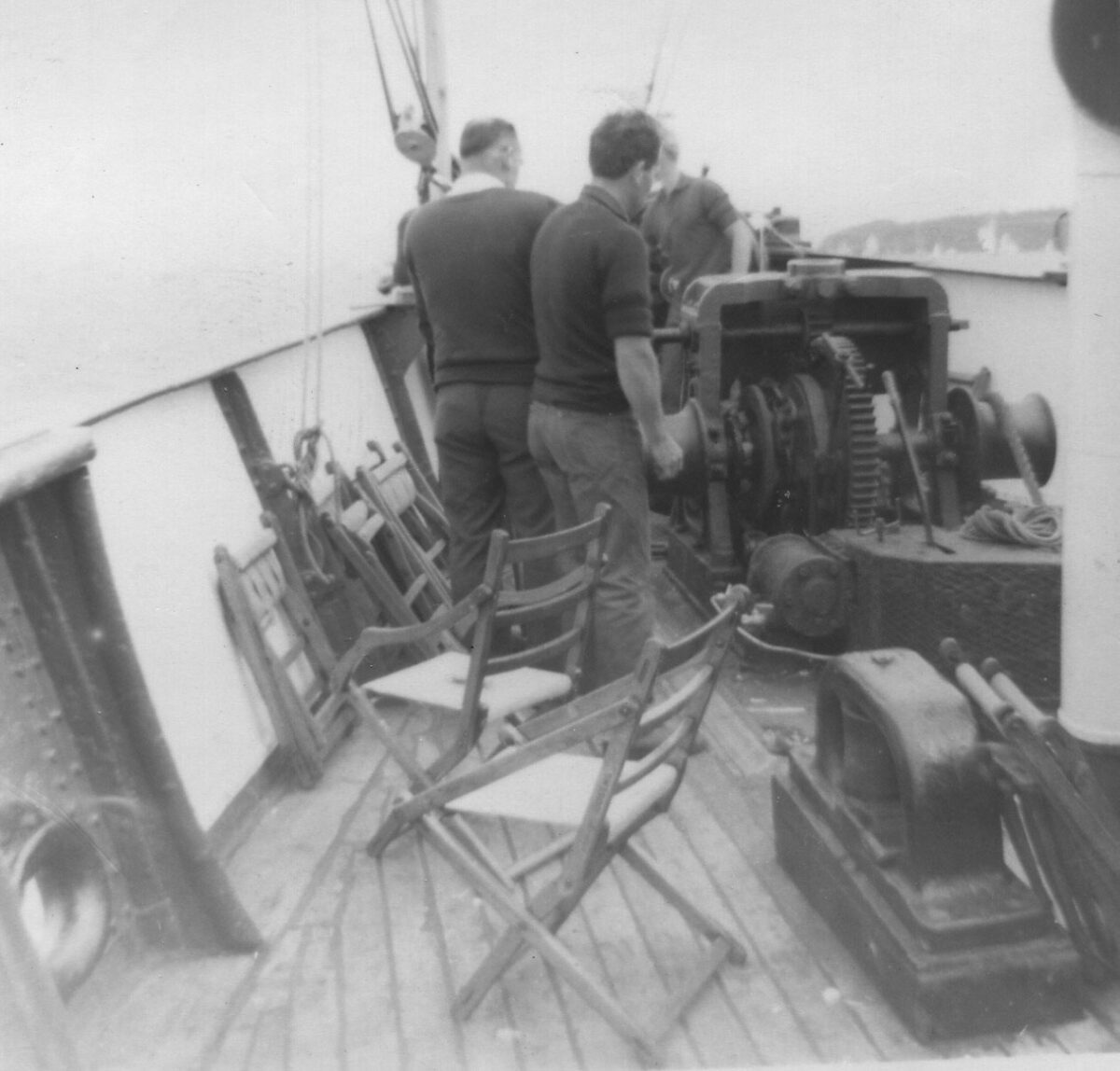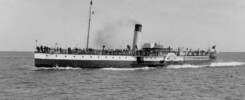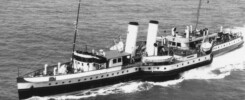
On Wednesday 7th August 1963 Embassy ran a day trip from Poole via Bournemouth to Yarmouth and Cowes, Isle of Wight.

By this stage in her career Embassy had largely abandoned long day trips to far distant destinations running instead on a more economic roster with lower operating costs alternating some days on the Bournemouth/Swanage service and more frequently a double run to either Totland Bay or Yarmouth from Bournemouth which a couple of times a week was extended to pick up at Swanage.
The Swanage and Bournemouth markets of holiday makers then largely preferred the shorter sea crossings particularly when combined with a 60 mile motor coach tour round the Isle of Wight on which they could get out to stretch their legs at resorts like Shanklin rather than being cooped up all day on a paddle steamer.
In 1963 there were two exceptions when longer day trips were offered extending the usual sailing to Yarmouth on to Cowes during Cowes Week to see close up the excitement of this Royal Regatta.

Dad and I joined a tiny handful of passengers boarding Embassy at Poole Quay for her 9am departure for the one on Wednesday 7th August. Slipping her berth Embassy steamed down through the Diver Channel, past “Aunt Betty” buoy, the Haven Hotel, from which Marconi had sent his earliest wireless messages in 1898, at Sandbanks and then on down the Swash Channel before turning northwards just inside the Poole Bar Buoy to make a course of 030 degrees for Bournemouth Pier where we arrived at 10.05.

There was a good crowd waiting and when we sailed on time at 10.30am Embassy was pretty much filled up to her capacity of 727 passengers. Course was then set on 105 degrees to sail south of the Christchurch Ledge buoy as Capt Iliffe and his mate Eric Plater took morning coffee and biscuits on the bridge. Take a magnifying glass to the picture above and you can just make out the Needles in the distance fine on the port bow.
The Christchurch Ledge buoy is now long gone but it was Cosens’s policy always to sail to the south of it and avoid passing over the Christchurch Ledge itself. There was enough water over most of it for Embassy but Cosens’s masters were told to avoid it both out of consideration for the fishermen who laid their crab and lobster pots on it and out of consideration for their paddle steamers as they preferred them not to catch the ropes from pots in the paddle wheels and wind them up from the bottom as occasionally happened elsewhere.
There are two routes into the Solent. Either you can proceed on towards the Needles Lighthouse and round up into the Needles Channel passing close to the SW Shingles buoy. Or you could take the North Channel, which in those days was unbuoyed, close in to the beach near Hurst Castle.
On this occasion Capt Ililffe chose the North Channel and I recall the mate Eric Plater saying over the tannoy something along the lines “If you look over on the port side over the beach, all those sticks sticking up you can see are the masts of yachts moored on the other side of the beach”. Capt Iliffe had always done the commentary when he was master of Consul but temperamentally he was a quiet man. On the other hand Mr Plater was more out going and liked to jolly the passengers along with his entertaining commentary. So Capt Iliffe left him to it.
We arrived at Yarmouth Pier at 12 noon where the overwhelming majority of passengers disembarked either to spend the time ashore looking around the pretty little town and having a quiet drink or lunch in one of the pubs or to take the motor coach tour around the island. So many went ashore that we were alongside for fifteen minutes disembarking them all before we were able to cast of at 12.15pm and set a course of 065 degrees for the Gurnard buoy off Egypt Point sailing up the western Solent to the north of the Hamstead Ledge, Salt Mead Ledge and Gurnard Ledge buoys. Capt Iliffe went below to take lunch in the dining saloon on the lower deck aft. Dad and I breathed a sigh of relief at all this extra space on Embassy with so few of us passengers bound for Cowes left aboard.

As we approached the Royal Yacht Britannia and her guard ship moored off Cowes there were not too many yachts to get in the way but when we turned south to enter the harbour between the Gurnard and Prince Consort buoys, the channel was full of sailing yachts and dinghies which made Capt Iliffe’s approach to moor alongside Fountain Pier somewhat tricky. We made fast at 1.20pm, about twenty minutes late, where a handful went ashore. Then ten minutes later we cast off and backed down the harbour into the Solent using the bow rudder.

Embassy then steamed around the Royal Yacht to give us all a good view although there was no sign of the Duke of Edinburgh who was alleged to be aboard. We were not due to pick up the handful who had gone ashore at Cowes until 3.45pm so Capt iliffe dropped the anchor. This was a great excitement for me as I had never seen a paddle steamer drop her anchor before. On most of Cosens’s paddle steamers this would have been quite a palaver as the anchors were generally stowed on deck and would have had to be lifted over the side using the anchor davit before they could be dropped. However Embassy did have a hawser pipe in which her anchor was already stowed so dropping it involved only removing the anchor claw, which holds the chain firmly in place, and letting off the break. Splash, rattle, rattle, rattle, down it went. When ships are at anchor the International Regulations for the Prevention of Collisions at Sea requires them to hoist an anchor ball to indicate to other shipping that they are at anchor. Embassy didn’t carry any of these approved shapes so a coir fender was hoisted in its place. Well it was round. And it did look like a ball.

This deck scene taken during the Cowes section of the day shows just how few takers there had been for this longer day trip.
Getting Embassy’s otherwise little used anchor up turned out to be harder than may have been hoped and it was not until 4pm that we were underway again and passing numbers 3 and 4 buoys in the approaches to the harbour where we once again berthed alongside Fountain Pier head in.
There was a long queue of people waiting for the Red Funnel ferry but of our tiny handful of passengers there was no sight. Then a voice from towards the back of the queue for Southampton called out plaintively “We want that boat.” “No you don’t” replied a pier hand. “You want the Southampton boat and that will be in next. This one is going to Bournemouth”. “But we want to go to Bournemouth” came the reply now in a more agitated tone. They were let through and off we went at 4.25pm with Embassy once again backing out using the bow rudder and making a difficult exit with all the yachts and dinghies in the way.
Then it was back down the Solent retracing our course of the morning to Yarmouth where we arrived at 5.25pm. We were now running late so mate Eric Plater took up his usual position by the loading gates chivvying the boarders on with the cry of “Hurry along on the gangway please”. This seemed to have the right effect as what had taken fifteen minutes to unload earlier in the day took only ten minutes to load now.
We sailed for Bournemouth at 5.35pm twenty minutes late once again taking the North Channel out of the Solent and passing to the southwards of the Christchurch Ledge buoy. Capt Iliffe could perhaps have chipped a few minutes of the ship’s lateness by sailing north of the buoy but he didn’t. He stuck to his instructions and all credit to him for that. And if he had sailed over the Christchurch Ledge and wound up a few crab or lobsters pots then that would have delayed us even further. Bournemouth was reached at 7.05pm still twenty minutes late.
Had Embassy been going back to Poole straight away Dad and I would likely have stayed on for that but she still had one more trip to run, a “Jazz Boat” with the Gerry Brown Jazzmen and the Downtown Syncopaters. This was due away at 8pm with a return to Poole Quay at midnight with coaches provided for the return to Bournemouth. This had to be as Embassy’s sea-going Class III Passenger Certificate was only valid in daylight hours and up to one hour after sunset. After that she had to be back in Poole Harbour to use her Class V PC which was valid day and night. Sunset on 7th August is around 8.45pm so one hour after that means that she would have had to be in by 9.45pm. That gave another two hours of cruising time to fill up within the harbour limits before the finish at midnight. Given the difficulty of turning Embassy in the confined reaches of Poole Harbour, if I had been Capt iliffe, I would have been inclined to find a nice quiet anchorage somewhere within the harbour and drop the hook to while most of this time away. After all on a Jazz Boat the passengers are bopping and drinking and soaking up the jazz not staring out at the passing scenery.
Dad and I walked back up through Bournemouth to the railway station to catch our train home to Weymouth stopping at a new Wimpey Bar for a “Wimpy” on the way. As a family we almost never ate out. We pretty much always ate nice food cooked at home or, when we were out, took a picnic. So a visit to an American style Wimpey Bar was something of a new experience for my 12 year old self. I recall thinking that the burgers topped with fried onions bore a passing resemblance to mum’s rissoles but actually weren’t anywhere near as nice.
Tiny Point of Detail 1: Embassy’s master from 1963 to her last season in 1966 was Captain J C W “John” Iliffe. Although he started out at sea in 1927 in the Merchant Navy, he joined the RNR before the war and remained in the Navy tself after the war retiring as a a Lieutenant Commander in 1958
He then joined Cosens as mate of the Consul in 1959 and was her master for the 1960 and 1962 seasons after which he displaced Captain Holleyoak from Embassy in 1963
Tiny Point of Detail 2: Captain Iliffe lived in quite a grand house in Buxton Road in Weymouth overlooking Portland Harbour so with Embassy based for her summers at Poole he stayed aboard from Sunday to Friday generally returning home for Embassy’s Saturdays off. Although he owned a rather natty sports car he saved on car parking charges during the week in Poole by making the 70 mile round trip astride his Lambretta.
Tiny Point of Detail 3: In his first season as master of Embassy he found that the bridge deck over the captain’s cabin leaked onto his bunk so used a piece of tarpaulin to cover him up and keep him dry as he slept. As a one time prisoner of war he was doubtless used to slumming it but during the winter of 1963/64 to solve this issue he had the bridge re-decked to make it more watertight. This also involved renewing the wooden front of the wheelhouse, which was starting to rot, in plywood which necessitated re-siting Embassy’s bell from its previous position on the front of the wheelhouse onto the mast.
Tiny Point of Detail 4: Another alteration Captain Iliffe instigated was the replacement of the coal-fired range in the galley, which was in the port sponson abaft the paddle wheel, with a gas stove. So from 1964 Embassy lost her characteristic buff and black topped galley chimney with its attendant smoke
Kingswear Castle returned to service in 2023 after the first part of a major rebuild which is designed to set her up for the next 25 years running on the River Dart. The Paddle Steamer Kingswear Castle Trust is now fund raising for the second phase of the rebuild. You can read more about the rebuilds and how you can help if you can here.
John Megoran
This article was first published on 7th August 2021.


